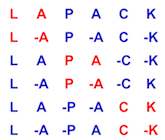 |
LAPACK 3.12.1
LAPACK: Linear Algebra PACKage
|
 |
LAPACK 3.12.1
LAPACK: Linear Algebra PACKage
|
| subroutine chprfs | ( | character | uplo, |
| integer | n, | ||
| integer | nrhs, | ||
| complex, dimension( * ) | ap, | ||
| complex, dimension( * ) | afp, | ||
| integer, dimension( * ) | ipiv, | ||
| complex, dimension( ldb, * ) | b, | ||
| integer | ldb, | ||
| complex, dimension( ldx, * ) | x, | ||
| integer | ldx, | ||
| real, dimension( * ) | ferr, | ||
| real, dimension( * ) | berr, | ||
| complex, dimension( * ) | work, | ||
| real, dimension( * ) | rwork, | ||
| integer | info ) |
CHPRFS
Download CHPRFS + dependencies [TGZ] [ZIP] [TXT]
!> !> CHPRFS improves the computed solution to a system of linear !> equations when the coefficient matrix is Hermitian indefinite !> and packed, and provides error bounds and backward error estimates !> for the solution. !>
| [in] | UPLO | !> UPLO is CHARACTER*1 !> = 'U': Upper triangle of A is stored; !> = 'L': Lower triangle of A is stored. !> |
| [in] | N | !> N is INTEGER !> The order of the matrix A. N >= 0. !> |
| [in] | NRHS | !> NRHS is INTEGER !> The number of right hand sides, i.e., the number of columns !> of the matrices B and X. NRHS >= 0. !> |
| [in] | AP | !> AP is COMPLEX array, dimension (N*(N+1)/2) !> The upper or lower triangle of the Hermitian matrix A, packed !> columnwise in a linear array. The j-th column of A is stored !> in the array AP as follows: !> if UPLO = 'U', AP(i + (j-1)*j/2) = A(i,j) for 1<=i<=j; !> if UPLO = 'L', AP(i + (j-1)*(2*n-j)/2) = A(i,j) for j<=i<=n. !> |
| [in] | AFP | !> AFP is COMPLEX array, dimension (N*(N+1)/2) !> The factored form of the matrix A. AFP contains the block !> diagonal matrix D and the multipliers used to obtain the !> factor U or L from the factorization A = U*D*U**H or !> A = L*D*L**H as computed by CHPTRF, stored as a packed !> triangular matrix. !> |
| [in] | IPIV | !> IPIV is INTEGER array, dimension (N) !> Details of the interchanges and the block structure of D !> as determined by CHPTRF. !> |
| [in] | B | !> B is COMPLEX array, dimension (LDB,NRHS) !> The right hand side matrix B. !> |
| [in] | LDB | !> LDB is INTEGER !> The leading dimension of the array B. LDB >= max(1,N). !> |
| [in,out] | X | !> X is COMPLEX array, dimension (LDX,NRHS) !> On entry, the solution matrix X, as computed by CHPTRS. !> On exit, the improved solution matrix X. !> |
| [in] | LDX | !> LDX is INTEGER !> The leading dimension of the array X. LDX >= max(1,N). !> |
| [out] | FERR | !> FERR is REAL array, dimension (NRHS) !> The estimated forward error bound for each solution vector !> X(j) (the j-th column of the solution matrix X). !> If XTRUE is the true solution corresponding to X(j), FERR(j) !> is an estimated upper bound for the magnitude of the largest !> element in (X(j) - XTRUE) divided by the magnitude of the !> largest element in X(j). The estimate is as reliable as !> the estimate for RCOND, and is almost always a slight !> overestimate of the true error. !> |
| [out] | BERR | !> BERR is REAL array, dimension (NRHS) !> The componentwise relative backward error of each solution !> vector X(j) (i.e., the smallest relative change in !> any element of A or B that makes X(j) an exact solution). !> |
| [out] | WORK | !> WORK is COMPLEX array, dimension (2*N) !> |
| [out] | RWORK | !> RWORK is REAL array, dimension (N) !> |
| [out] | INFO | !> INFO is INTEGER !> = 0: successful exit !> < 0: if INFO = -i, the i-th argument had an illegal value !> |
!> ITMAX is the maximum number of steps of iterative refinement. !>
Definition at line 176 of file chprfs.f.